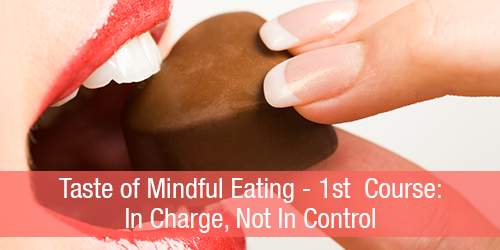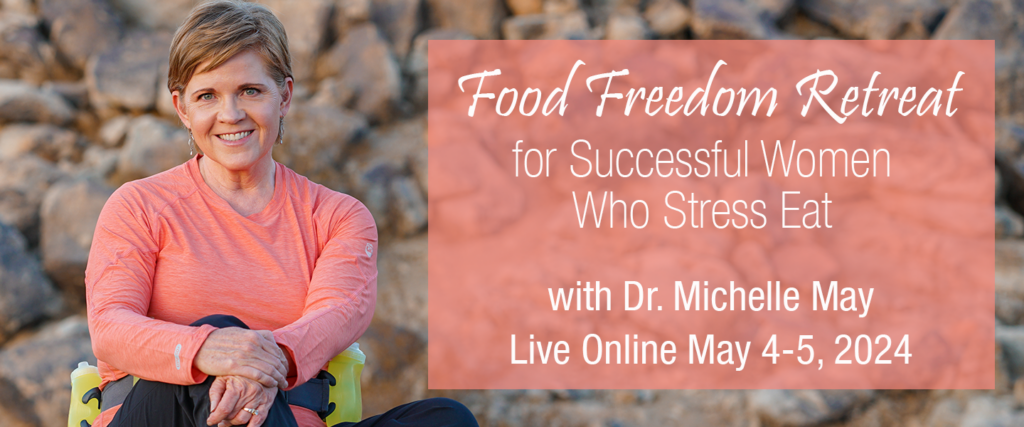In this first course of a Taste of Mindful Eating, we’ll explore why you struggle with eating and talk about what it means to be in charge, not in control.
Begin by asking yourself these questions:
- Do I often think about food and eating?
- Do I feel guilty when I eat certain foods?
- Do I have trouble passing up food even if I’m not hungry?
- Do I eat when I’m bored, stressed, lonely, or angry?
- Do I frequently feel really full after I eat?
- Do I eat differently in private than I do in public?
- Do I fluctuate between dieting and eating too much?
If you answered yes to any of these questions, you’ve probably already discovered that your attempts at dieting or the commitments you’ve made to “eat right and exercise” often lose steam.
You are not alone!
Why do I have a hard time sticking to a diet?
One of the reasons diets don’t work long term is they focus on what to eat.
Eating is more complex than that!
It’s not just about what you’re eating, but why you’re eating in the first place!
Why Do I Eat?
To help you develop a better understanding of why you eat, let’s take a look at four different eating patterns: Instinctive Eating, Overeating, Restrictive Eating, and the Eat-Repent-Repeat Cycle.
Instinctive Eating
Think about someone who doesn’t struggle with their eating. (If you’re having trouble thinking of someone like that, think of a baby or a young child.)
We call this “Instinctive Eating.” People who eat instinctively just seem to know when, what, and how much food they need.
 When their body needs fuel, they get hungry, triggering their desire to eat.
When their body needs fuel, they get hungry, triggering their desire to eat.- They usually stop eating when their hunger is satisfied, even if there’s food left on their plate.
- They seem to be able to eat whatever they want, but they might turn down even delicious food if they aren’t hungry.
- They enjoy food—but they don’t “live to eat”!
Overeating
In “Overeating,” you’re eating for reasons other than hunger.
Maybe you eat because it’s mealtime, because something looks good, to distract yourself, or to cope with stress and emotions.
For example, do you eat to reward, comfort, or entertain yourself with food? As we’ll explore in a future lesson, eating typically only works temporarily, so you may find yourself eating again and again.
When you’re in an Overeating Cycle, you may feel out of control.
Restrictive Eating
When you feel overwhelmed by overeating, you may decide to start another diet.
You decide when, what, and how much to eat based on the latest diet you’re following.
In a Restrictive Eating Cycle, you attempt to control your eating with rules.
Since diet rules are always changing, you may sometimes feel confused about what you should eat.
You think of food as “good” or “bad” – and think of yourself as good or bad, depending on what you ate.
Eat-Repent-Repeat Cycle
Because diets are unsustainable, most people vacillate between Overeating and Restrictive Eating. This is the eat-repent-repeat cycle.
When you eat what you want, you feel guilty.
When you eat what you think you “should,” you feel deprived.
As a result, you develop a love-hate relationship with food.
And your self-esteem tends to go up and down depending on whether you are on or off your diet.
Mindful Eating
Maybe you believe a person who eats instinctively has a lot of willpower and a great metabolism.
The truth is we were all born with the ability to eat instinctively!
It’s just that many of us “unlearned” our natural ability to know when and how much to eat.
The good news is if you’re ready to break old, ineffective patterns, you can relearn those skills through a process called mindful eating.
I did! And I want to show you how you can too!
When you eat mindfully, you’re in charge of your choices.
By learning to be in charge of your eating you’ll learn how to:
- Manage your eating without yo-yo dieting.
- Eat the foods you love without guilt.
- Eat the same when you’re alone as you do in public.
- Cope with “head hunger.”
- Find freedom and joy in eating.
Food for Thought
The simplest definition of mindfulness is awareness. Awareness is the first step to change!
Take a few moments to consider your answers to the following questions.
- Would you describe your “eating style” as mostly Instinctive Eating, Overeating, Restrictive Eating, or the Eat-Repent-Repeat cycle? (If you’re having difficulty figuring out what your eating pattern is, take our Eating Cycle Assessment; see below.)
- Journal about a recent eating episodes that demonstrates your primary eating pattern.
Recipe for Success
- Take our Eating Cycle Assessment to figure out what your primary eating pattern is.
- Read or reread the first Chapter of Eat What You Love, Love What You Eat: A Mindful Eating Program to Break Your Eat-Repent-Repeat Cycle.
Your next helping
- Your next Taste of Food Freedom is Trust Your Body Wisdom. In this lesson, you’ll learn simple ways to understand what your body is telling you.
- You can come back to review In Charge, Not In Control anytime; simply bookmark this page to review it.


